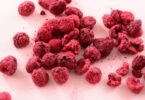Learn how to dehydrate food in the oven.
Dehydrating vegetables and fruits is an ideal way to reduce food packaging and make your food last. This is also practical for emergency storage and outdoor adventures. If you have a seasonal harvest, drying your fresh produce helps you store it for the next season.
READ ALSO: 10 Amazing Benefits of Dehydrating Food
If you have an oven at home, you can use this kitchen appliance to dehydrate different types of foods. However, the best ones are fruits and vegetables including peaches, cherries, mushrooms, beans, and onions. So, are you ready for dehydrating foods in the oven? Just follow the tips below to start dehydrating your favorite ingredients.
How To Dehydrate Food in the Oven
Preparing foods for dehydrating
The most important factor to consider when preparing your food for drying is even thickness. When your slices are evenly thick, they will dry at a uniform rate. As a result, you get equally dried foods after the dehydration process. Uneven thickness, on the other hand, may lead to spoiling during storage.
To help you achieve even thickness, it’s important to use appropriate tools. For instance, you can use a slicing device to make sure your cuts are equal in inches. Cast iron slicing device is one of the most common tools in the kitchen that has been used for two decades already and is still essential in households.
For dehydrating fruits such as pears and apples, this tool works more efficiently when it comes to slicing, peeling, and coring simultaneously. If you are planning to buy your own slicing device, find a product that doesn’t consist of plastic parts.
Depending on the product, peeling is sometimes unnecessary when dehydrating food. The only reason for this is that removing the skin from your fruit helps avoid imperfections that may cause uneven cooking and poor taste. Also, if you think there are pesticides used, peeling can help eliminate the toxins.
Dehydrating foods in the oven
Oven drying slowly dehydrates food at around 140 – 200 degrees Fahrenheit (60 – 100 degrees Celsius). The oven is a good alternative if you don’t have an electric dehydrator or other means to preserve your fruits, veggies, and meat.
One of the reasons why some people don’t opt for dehydrating food in the oven is the tendency of this appliance to warm up the house. Therefore, it’s important to make sure that the oven temperature is low enough, to safely dry your food.
An oven may take at least 2 times longer than an electric dehydrator. So if you don’t mind drying in a slower method, then this is a good option for you to dehydrate your foods. Here are some helpful tips if you want to use your oven for dehydrating fruits and vegetables.
- Make sure the dial shows 140 degrees Fahrenheit or lower. You can also set the oven to “Keep Warm” to dry your food instead of cooking it. Check the thermostat before putting your fruits or vegetables inside the oven.
- Oven thermometers that are located beside the food often provide a more accurate reading.
- To help improve air circulation, you can leave the door open for at least 2 inches and place an electric fan near the oven to direct the heat outside.
Important things to keep in mind
Dehydrating your foods at high temperatures may kill the enzymes. However, denser foods are often capable of withstanding high temperatures so they retain the enzymes. Note that most enzymes become inactive at temperatures higher than 14o to 158 degrees Fahrenheit.
Unlike dehydrators, using the oven to dehydrate foods may take at least 8 hours. This method offers a slow process of drying which is a good factor to consider if you want a faster way to dry your harvest. However, never shortcut the time for oven drying because it will lead to case hardening wherein the outside part of the food is dried while the inside is still moist.
You don’t need to attend to your food once it’s inside the oven. That means you can do other chores while waiting for your food to dry since it’s a long process that requires more time than other drying methods. However, you can do some checking after a few hours just to make sure they are drying properly.
Ovens without adequate ventilation may need you to crack the door open a bit to avoid moisture buildup. Adjust or turn the pans after a few hours if there are hot spots in your oven to make sure the drying rate is the same. If you notice your food has shrunk and is completely dry, it’s all good for cooling.
Once the food is cool, you can prepare your storage containers so you can keep it in a safe place like your kitchen cabinet. You can eat it as a snack or add to your cooking for a more delicious meal. It’s one of the most convenient ways to ensure you have what you need when you need it.
READ ALSO
Having excess produce for your seasonal harvest can be managed with drying. It helps preserve your food so you can have it even if it’s off-season or not available in the market. Plus, dried food is more nutritious than your supermarket favorites which are mostly preserved with artificial flavors.
Aside from keeping your grocery expenses down, oven drying also provides a healthier and fun way to preserve your fruits, vegetables, and meat. So, what food are you drying today in your oven?
Frequently asked questions about dehydrating food in the oven
How do I use my oven as a food dryer?
While it is possible to use your oven to dry food (as I have described above), it is not the best or most efficient method. Most ovens do not have a low enough temperature setting to safely dry food, and the heat from the oven can cause the food to cook or burn. It is best to use a dedicated food dehydrator for drying food.
How long does it take to dehydrate in an oven?
The length of time it takes to dehydrate food in an oven will depend on several factors, including the type of food being dehydrated, the temperature of the oven, and the desired level of dryness. In general, it can take several hours to dehydrate food in an oven, and it may require rotating the food and adjusting the temperature to ensure that it dries evenly without burning.
What temperature should my oven be to dehydrate?
Most ovens do not have a low enough temperature setting to safely dehydrate food. Most food dehydrators have temperature settings that range from around 95 to 165 degrees Fahrenheit, which is the optimal range for drying food. Ovens typically have a minimum temperature setting of around 170 to 200 degrees Fahrenheit. Your oven should be at the lowest possible temperature setting.
Is it worth it to dehydrate your own food?
Dehydrating your own food can be a worthwhile and rewarding process. Dehydrating food preserves it by removing moisture, which can slow down the growth of bacteria and other microorganisms. This allows the food to be stored for longer periods of time without spoiling. Dehydrating your own food can also save you money compared to buying commercially dehydrated foods, and it allows you to control the ingredients and seasonings used. Additionally, dry food is lightweight and convenient to pack and carry, making them great for camping, hiking, and other outdoor activities.





